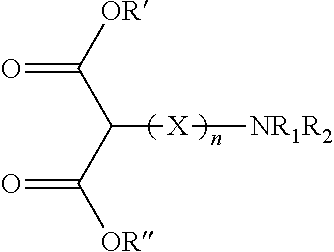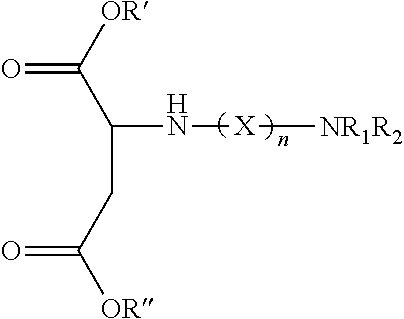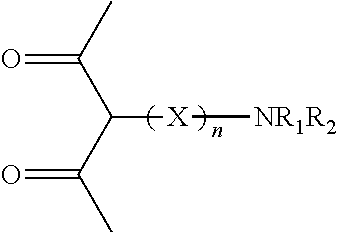Laminates prepared from decor paper comprising self-dispersing pigments
a technology of decor paper and pigments, applied in the field of self-dispersing inorganic particles, can solve the problems of loss of paper tensile strength, poor opacity, wet or dry appearance of finished sheets,
- Summary
- Abstract
- Description
- Claims
- Application Information
AI Technical Summary
Benefits of technology
Problems solved by technology
Method used
Image
Examples
example 1
[0099]200 g. of a 30% (w / w) slurry of an alumina coated titanium dioxide pigment (DuPont R-796) is charged into a jacketed 250 mL beaker and heated to 55° C. The slurry is stirred throughout the course of surface treatment using a propeller blade attached to an overhead stirrer. The pH of this slurry measures 5.5 at 55° C. 14.6 g. of a sodium silicate sol having 28.7% SiO2 content (about 7% SiO2 based on pigment weight) is charged into a 20 cc syringe. The sol is added at a rate of 0.7 mL / min so that time for complete addition occurs within 20 min. The pH is maintained between 5.0 to 5.5 during the course of silicate addition by simultaneous addition of 20% HCl solution. After silicate addition is complete, this mixture is held at pH and temperature for 30 min. 18.8 g. of a 43% sodium aluminate sol (24% Al2O3 content, about 7% Al2O3 based on pigment weight) is charged into a 20 cc syringe. The sol is added at a rate so that addition occurs within 10 min. The pH is allowed to rise to...
example 2
[0100]200 g. of a 30% (w / w) slurry of an alumina coated titanium dioxide pigment (DuPont R-796) is charged into a jacketed 250 mL beaker and heated to 55° C. The slurry is stirred using a propeller blade attached to an overhead stirrer. 14.6 g. of a sodium silicate sol having 28.7% SiO2 content (about 7% SiO2 based on pigment weight) is charged into a 20 cc syringe. The sol is added at a rate such that time for complete addition occurs within 20 min. pH is maintained between 5.0 to 5.5 during the course of silicate addition by simultaneous addition of 20% HCl solution. After silicate addition is completed, this mixture is held at pH and temperature for 30 min. 18.8 g. of a 43% sodium aluminate sol (24% Al2O3 content, about 7% Al2O3 based on pigment weight) is charged into a 20 cc syringe. The sol is added at a rate so that addition occurs within 10 min. The pH is allowed to rise to 10 and simultaneous addition of 20% HCl solution is commenced to maintain a pH of 10. After aluminate ...
example 3
[0101]3330 g. of a 30% (w / w) solids R-796 slurry (i.e. enough to yield about 1 Kg. dried pigment) is charged into a 5 L stainless steel pail and heated to 55° C. on a hot plate. The slurry is stirred throughout using a propeller blade attached to an overhead stirrer. 242 g. of sodium silicate sol having 28.7% SiO2 content (about 7% SiO2 based on pigment weight) is charged into an addition funnel mounted above the pail. The silica sol is added at a rate so that time for complete addition occurs within 20 min. The pH is maintain between 5.0 to 5.5 during the course of silicate addition by simultaneous addition of 20% HCl solution. After silicate addition is completed, this mixture is held at pH and temperature for 30 min. Next, 310 g. of a 43% sodium aluminate sol (about 7% Al2O3 based on pigment weight) is added in a similar fashion. The rate of addition is controlled so that the contents of the funnel are added within 20 min. The pH is allowed to rise to 10 and simultaneous addition...
PUM
| Property | Measurement | Unit |
|---|---|---|
| Fraction | aaaaa | aaaaa |
| Fraction | aaaaa | aaaaa |
| Weight | aaaaa | aaaaa |
Abstract
Description
Claims
Application Information
 Login to View More
Login to View More - R&D
- Intellectual Property
- Life Sciences
- Materials
- Tech Scout
- Unparalleled Data Quality
- Higher Quality Content
- 60% Fewer Hallucinations
Browse by: Latest US Patents, China's latest patents, Technical Efficacy Thesaurus, Application Domain, Technology Topic, Popular Technical Reports.
© 2025 PatSnap. All rights reserved.Legal|Privacy policy|Modern Slavery Act Transparency Statement|Sitemap|About US| Contact US: help@patsnap.com



